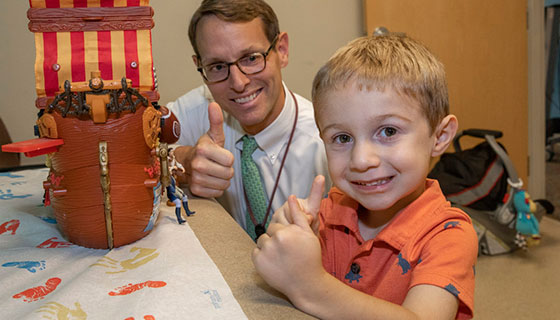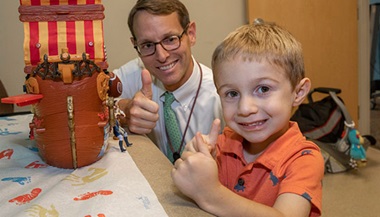Osteomyelitis
What You Need to Know
- Osteomyelitis is inflammation or swelling that occurs in the bone.
- It can result from an infection somewhere else in the body that has spread to the bone, or it can start in the bone — often as a result of an injury.
- Osteomyelitis is more common in younger children (five and under) but can happen at any age.
- Boys are usually more affected than girls.
- Antibiotics are often prescribed to treat osteomyelitis. Surgery may also be recommended in certain cases.
What is osteomyelitis?
Osteomyelitis is an inflammation or swelling of bone tissue that is usually the result of an infection. Bone infection may occur for many different reasons and can affect children or adults.
-
Osteomyelitis may occur as a result of a bacterial bloodstream infection, sometimes called bacteremia, or sepsis, that spreads to the bone. This type is most common in infants and children and usually affects their long bones like the femur (thighbone) or humerus (upper arm bone). When osteomyelitis affects adults, it often involves the vertebral bones along the spinal column. The source of the blood infection is usually Staphylococcus aureus, although it may be caused by a different type of bacteria or fungal organism
-
Osteomyelitis can also occur from a nearby infection due to a traumatic injury, frequent medication injections, a surgical procedure or use of a prosthetic device. In addition, individuals with diabetes who develop foot ulcers are more susceptible. In any of these situations, the organism has a direct portal of entry into the affected bone.
-
Individuals with weakened immune systems are more likely to develop osteomyelitis. This includes people with sickle cell disease or HIV or those receiving immunosuppressive medications like chemotherapy or steroids.
Osteomyelitis can have a sudden onset, a slow and mild onset or may be a chronic problem, depending on the source of the infection.
What are the symptoms of osteomyelitis?
Symptoms of osteomyelitis vary, depending on the cause and whether it is a rapid or slow onset of infection. The following are the most common symptoms of osteomyelitis; however, each individual may experience symptoms differently:
-
Fever (may be high when osteomyelitis occurs as the result of a blood infection)
-
Pain and tenderness in the affected area
-
Irritability in infants who can’t express pain
-
Feeling ill
-
Swelling of the affected area
-
Redness in the affected area
-
Warmth in the affected area
-
Difficulty moving joints near the affected area
-
Difficulty bearing weight or walking
-
A new limp
-
A stiff back (with vertebral involvement)
The symptoms of osteomyelitis may resemble other medical conditions or problems. Always consult your doctor for a diagnosis.
How is osteomyelitis diagnosed?
The provider treating your child will first do a thorough history and physical exam that may indicate signs of osteomyelitis like those listed above. An additional workup generally includes blood tests that look at white blood cells as well as markers for inflammation that are usually elevated during an infection. A blood culture may also be done to look for organisms in the blood that may be causing the infection.
X-rays are taken of the affected area. However, they may be normal in early stages of the infection. Magnetic resonance imaging (MRI) or bone scans may be recommended to identify the cause of bone pain or inflammation. Computed tomography (CT) scans can be helpful in later stages of osteomyelitis.
Finally, bone aspirations or biopsies are useful in the diagnosis of osteomyelitis and to determine the most appropriate treatment. In children, these procedures are most often done in the operating room under general anesthesia.
Treatment for Osteomyelitis
Specific treatment for osteomyelitis will be determined by your doctor based on:
-
Your age, overall health and medical history
-
Extent of the condition
-
Your tolerance for specific medications, procedures and therapies
-
Expectation for the course of the condition
-
Your opinion or preference
The goal for treatment of osteomyelitis is to cure the infection and minimize any long-term complications. Treatment may include:
-
Medications. Administration of intravenous (IV) antibiotics, which may require hospitalization or may be given on an outpatient schedule. Intravenous or oral antibiotic treatment for osteomyelitis may be very extensive, lasting for many weeks. It is important for the patient to continue to take antibiotics for as long as recommended by the treatment team, even after symptoms of the infection have resolved.
-
Monitoring of successive X-rays and blood tests
-
Pain management
-
Bed rest (or restricted movement of the affected area)
-
Surgery. In some cases, surgical intervention may be necessary to drain infectious fluid, or to remove damaged tissue and bone.
Long-term Considerations for Osteomyelitis
Osteomyelitis requires long-term care to prevent further complications, including care to prevent the following:
-
Fractures of the affected bone
-
Stunted growth in children (if the infection has involved the growth plate)
-
Gangrene infection in the affected area






